University Sustainable Energy-Investigating Low/Zero Carbon Technology
VerifiedAdded on 2022/12/18
|18
|4445
|21
Report
AI Summary
This report, focusing on low/zero carbon energy technologies, examines the current state of district heating in Sweden. It explores various technologies, including heat pumps, wood heating, CHP systems, solar thermal systems, and hybrid systems, and their impact on the energy system. The report highlights technical developments like combined CHP systems and the application of sophisticated and hybrid systems. It also discusses the barriers and opportunities associated with low-carbon district heating, such as regulatory challenges and the potential to set a benchmark for other countries. The report details the role of district heating in achieving national policy objectives, promoting economic benefits, and utilizing local resources. It concludes with a personal view on the technology's potential to transition to a cost-effective low-carbon energy system.
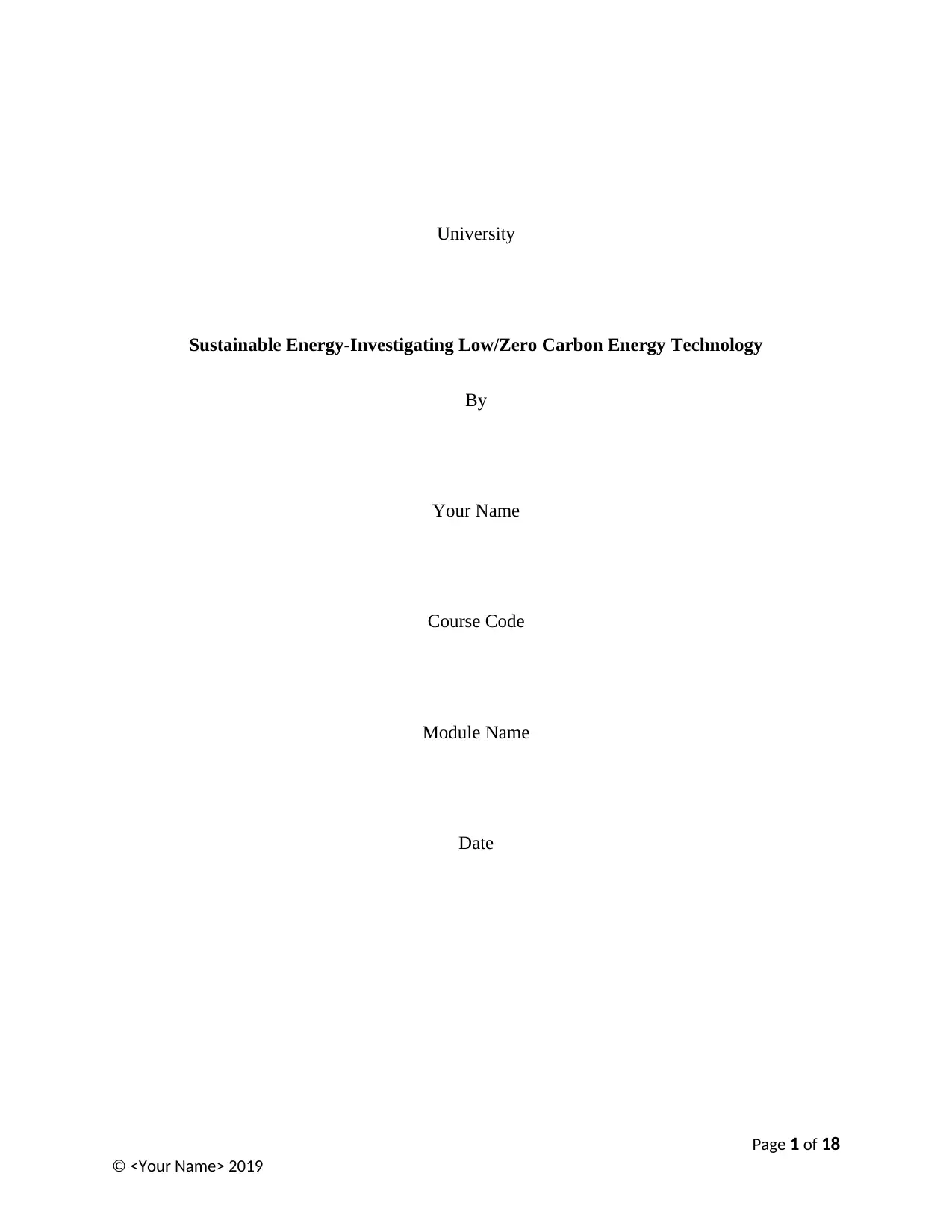
University
Sustainable Energy-Investigating Low/Zero Carbon Energy Technology
By
Your Name
Course Code
Module Name
Date
Page 1 of 18
© <Your Name> 2019
Sustainable Energy-Investigating Low/Zero Carbon Energy Technology
By
Your Name
Course Code
Module Name
Date
Page 1 of 18
© <Your Name> 2019
Paraphrase This Document
Need a fresh take? Get an instant paraphrase of this document with our AI Paraphraser
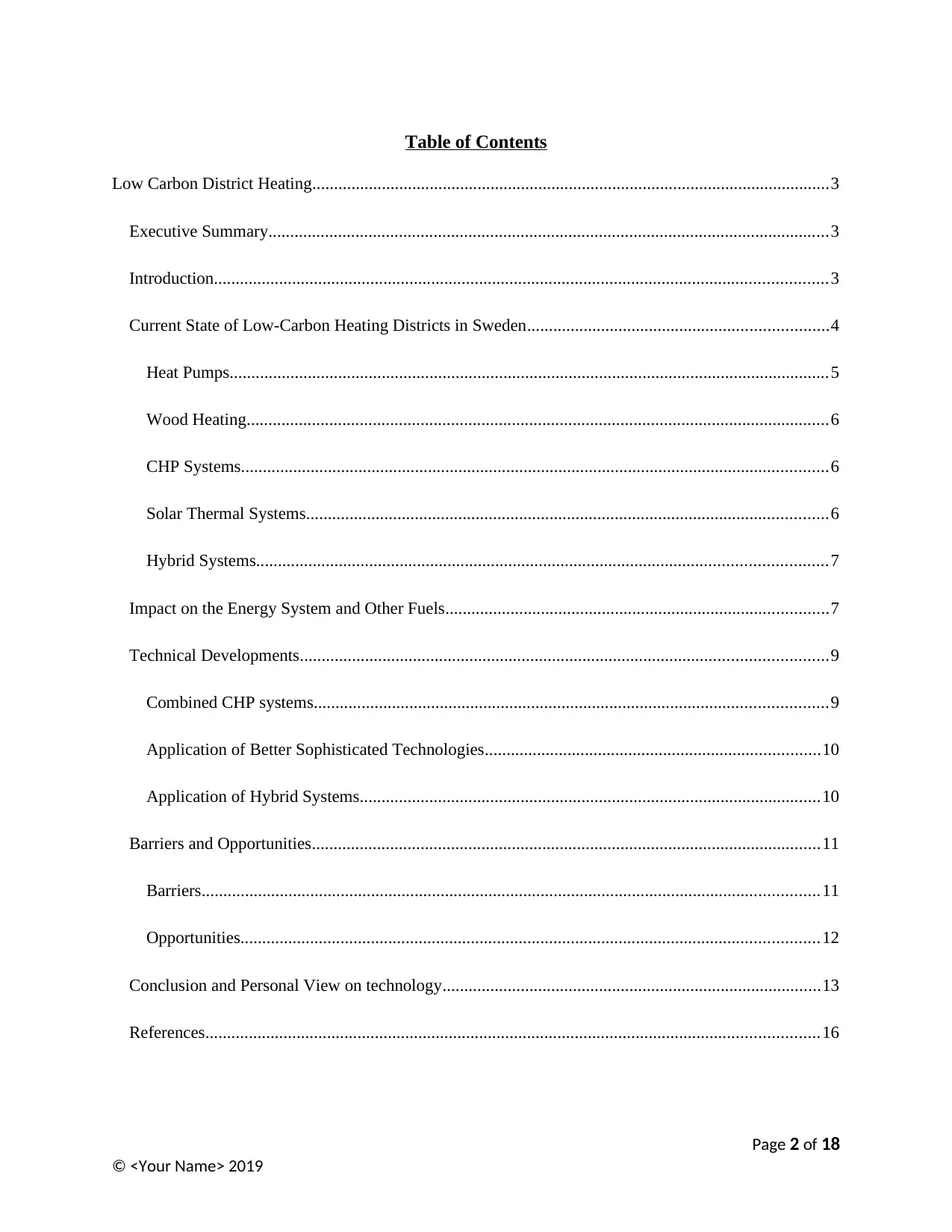
Table of Contents
Low Carbon District Heating.......................................................................................................................3
Executive Summary.................................................................................................................................3
Introduction.............................................................................................................................................3
Current State of Low-Carbon Heating Districts in Sweden.....................................................................4
Heat Pumps..........................................................................................................................................5
Wood Heating......................................................................................................................................6
CHP Systems.......................................................................................................................................6
Solar Thermal Systems........................................................................................................................6
Hybrid Systems...................................................................................................................................7
Impact on the Energy System and Other Fuels........................................................................................7
Technical Developments.........................................................................................................................9
Combined CHP systems......................................................................................................................9
Application of Better Sophisticated Technologies.............................................................................10
Application of Hybrid Systems..........................................................................................................10
Barriers and Opportunities.....................................................................................................................11
Barriers..............................................................................................................................................11
Opportunities.....................................................................................................................................12
Conclusion and Personal View on technology.......................................................................................13
References.............................................................................................................................................16
Page 2 of 18
© <Your Name> 2019
Low Carbon District Heating.......................................................................................................................3
Executive Summary.................................................................................................................................3
Introduction.............................................................................................................................................3
Current State of Low-Carbon Heating Districts in Sweden.....................................................................4
Heat Pumps..........................................................................................................................................5
Wood Heating......................................................................................................................................6
CHP Systems.......................................................................................................................................6
Solar Thermal Systems........................................................................................................................6
Hybrid Systems...................................................................................................................................7
Impact on the Energy System and Other Fuels........................................................................................7
Technical Developments.........................................................................................................................9
Combined CHP systems......................................................................................................................9
Application of Better Sophisticated Technologies.............................................................................10
Application of Hybrid Systems..........................................................................................................10
Barriers and Opportunities.....................................................................................................................11
Barriers..............................................................................................................................................11
Opportunities.....................................................................................................................................12
Conclusion and Personal View on technology.......................................................................................13
References.............................................................................................................................................16
Page 2 of 18
© <Your Name> 2019
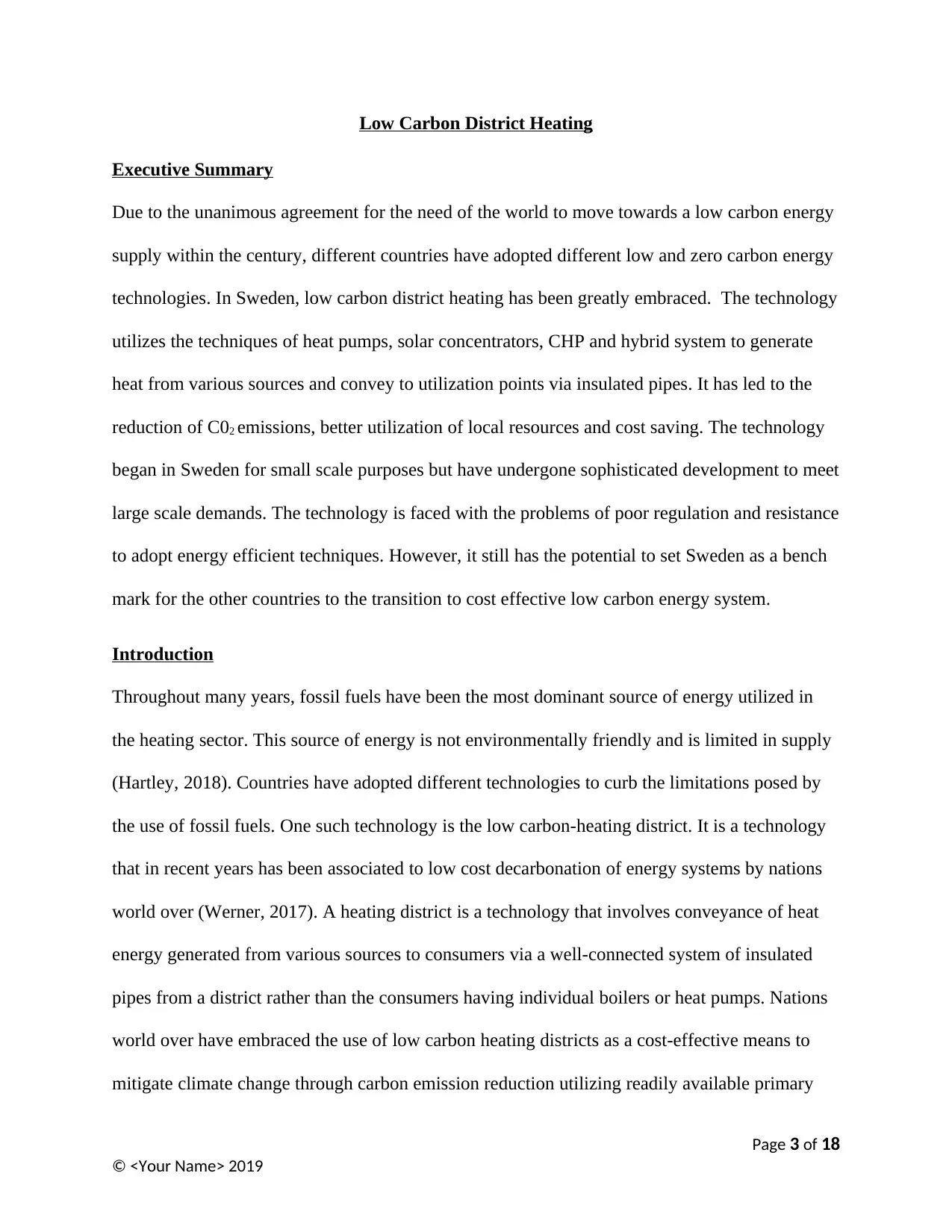
Low Carbon District Heating
Executive Summary
Due to the unanimous agreement for the need of the world to move towards a low carbon energy
supply within the century, different countries have adopted different low and zero carbon energy
technologies. In Sweden, low carbon district heating has been greatly embraced. The technology
utilizes the techniques of heat pumps, solar concentrators, CHP and hybrid system to generate
heat from various sources and convey to utilization points via insulated pipes. It has led to the
reduction of C02 emissions, better utilization of local resources and cost saving. The technology
began in Sweden for small scale purposes but have undergone sophisticated development to meet
large scale demands. The technology is faced with the problems of poor regulation and resistance
to adopt energy efficient techniques. However, it still has the potential to set Sweden as a bench
mark for the other countries to the transition to cost effective low carbon energy system.
Introduction
Throughout many years, fossil fuels have been the most dominant source of energy utilized in
the heating sector. This source of energy is not environmentally friendly and is limited in supply
(Hartley, 2018). Countries have adopted different technologies to curb the limitations posed by
the use of fossil fuels. One such technology is the low carbon-heating district. It is a technology
that in recent years has been associated to low cost decarbonation of energy systems by nations
world over (Werner, 2017). A heating district is a technology that involves conveyance of heat
energy generated from various sources to consumers via a well-connected system of insulated
pipes from a district rather than the consumers having individual boilers or heat pumps. Nations
world over have embraced the use of low carbon heating districts as a cost-effective means to
mitigate climate change through carbon emission reduction utilizing readily available primary
Page 3 of 18
© <Your Name> 2019
Executive Summary
Due to the unanimous agreement for the need of the world to move towards a low carbon energy
supply within the century, different countries have adopted different low and zero carbon energy
technologies. In Sweden, low carbon district heating has been greatly embraced. The technology
utilizes the techniques of heat pumps, solar concentrators, CHP and hybrid system to generate
heat from various sources and convey to utilization points via insulated pipes. It has led to the
reduction of C02 emissions, better utilization of local resources and cost saving. The technology
began in Sweden for small scale purposes but have undergone sophisticated development to meet
large scale demands. The technology is faced with the problems of poor regulation and resistance
to adopt energy efficient techniques. However, it still has the potential to set Sweden as a bench
mark for the other countries to the transition to cost effective low carbon energy system.
Introduction
Throughout many years, fossil fuels have been the most dominant source of energy utilized in
the heating sector. This source of energy is not environmentally friendly and is limited in supply
(Hartley, 2018). Countries have adopted different technologies to curb the limitations posed by
the use of fossil fuels. One such technology is the low carbon-heating district. It is a technology
that in recent years has been associated to low cost decarbonation of energy systems by nations
world over (Werner, 2017). A heating district is a technology that involves conveyance of heat
energy generated from various sources to consumers via a well-connected system of insulated
pipes from a district rather than the consumers having individual boilers or heat pumps. Nations
world over have embraced the use of low carbon heating districts as a cost-effective means to
mitigate climate change through carbon emission reduction utilizing readily available primary
Page 3 of 18
© <Your Name> 2019
⊘ This is a preview!⊘
Do you want full access?
Subscribe today to unlock all pages.

Trusted by 1+ million students worldwide
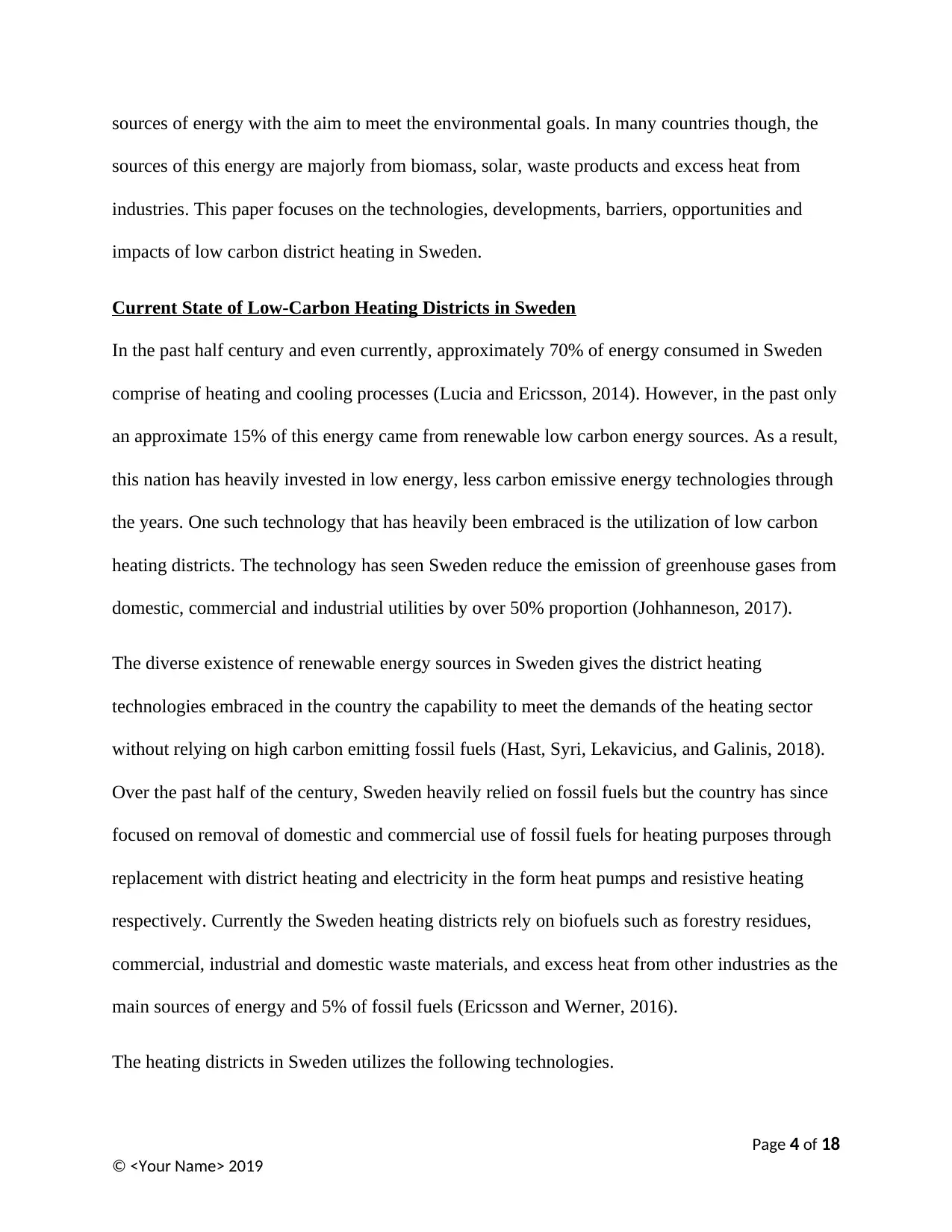
sources of energy with the aim to meet the environmental goals. In many countries though, the
sources of this energy are majorly from biomass, solar, waste products and excess heat from
industries. This paper focuses on the technologies, developments, barriers, opportunities and
impacts of low carbon district heating in Sweden.
Current State of Low-Carbon Heating Districts in Sweden
In the past half century and even currently, approximately 70% of energy consumed in Sweden
comprise of heating and cooling processes (Lucia and Ericsson, 2014). However, in the past only
an approximate 15% of this energy came from renewable low carbon energy sources. As a result,
this nation has heavily invested in low energy, less carbon emissive energy technologies through
the years. One such technology that has heavily been embraced is the utilization of low carbon
heating districts. The technology has seen Sweden reduce the emission of greenhouse gases from
domestic, commercial and industrial utilities by over 50% proportion (Johhanneson, 2017).
The diverse existence of renewable energy sources in Sweden gives the district heating
technologies embraced in the country the capability to meet the demands of the heating sector
without relying on high carbon emitting fossil fuels (Hast, Syri, Lekavicius, and Galinis, 2018).
Over the past half of the century, Sweden heavily relied on fossil fuels but the country has since
focused on removal of domestic and commercial use of fossil fuels for heating purposes through
replacement with district heating and electricity in the form heat pumps and resistive heating
respectively. Currently the Sweden heating districts rely on biofuels such as forestry residues,
commercial, industrial and domestic waste materials, and excess heat from other industries as the
main sources of energy and 5% of fossil fuels (Ericsson and Werner, 2016).
The heating districts in Sweden utilizes the following technologies.
Page 4 of 18
© <Your Name> 2019
sources of this energy are majorly from biomass, solar, waste products and excess heat from
industries. This paper focuses on the technologies, developments, barriers, opportunities and
impacts of low carbon district heating in Sweden.
Current State of Low-Carbon Heating Districts in Sweden
In the past half century and even currently, approximately 70% of energy consumed in Sweden
comprise of heating and cooling processes (Lucia and Ericsson, 2014). However, in the past only
an approximate 15% of this energy came from renewable low carbon energy sources. As a result,
this nation has heavily invested in low energy, less carbon emissive energy technologies through
the years. One such technology that has heavily been embraced is the utilization of low carbon
heating districts. The technology has seen Sweden reduce the emission of greenhouse gases from
domestic, commercial and industrial utilities by over 50% proportion (Johhanneson, 2017).
The diverse existence of renewable energy sources in Sweden gives the district heating
technologies embraced in the country the capability to meet the demands of the heating sector
without relying on high carbon emitting fossil fuels (Hast, Syri, Lekavicius, and Galinis, 2018).
Over the past half of the century, Sweden heavily relied on fossil fuels but the country has since
focused on removal of domestic and commercial use of fossil fuels for heating purposes through
replacement with district heating and electricity in the form heat pumps and resistive heating
respectively. Currently the Sweden heating districts rely on biofuels such as forestry residues,
commercial, industrial and domestic waste materials, and excess heat from other industries as the
main sources of energy and 5% of fossil fuels (Ericsson and Werner, 2016).
The heating districts in Sweden utilizes the following technologies.
Page 4 of 18
© <Your Name> 2019
Paraphrase This Document
Need a fresh take? Get an instant paraphrase of this document with our AI Paraphraser
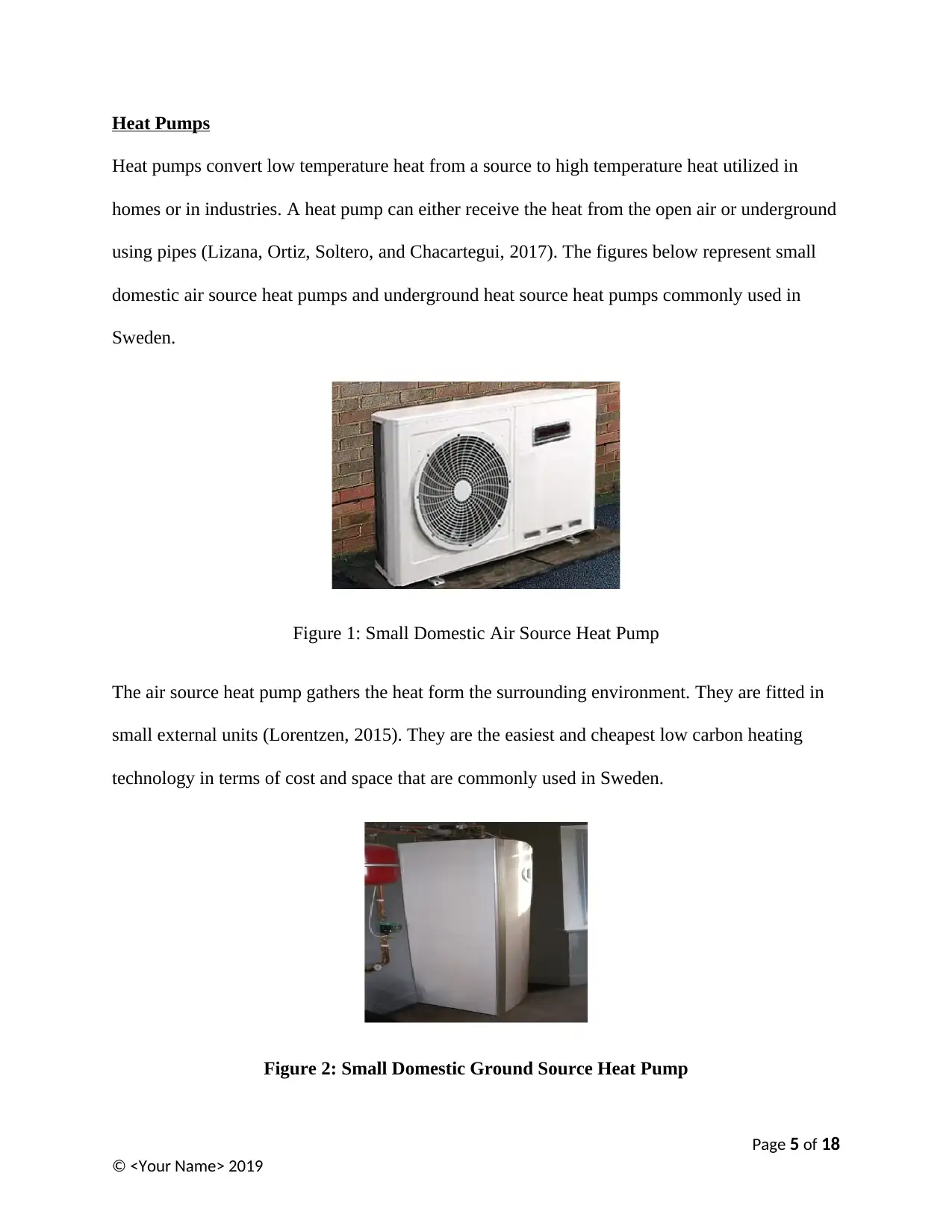
Heat Pumps
Heat pumps convert low temperature heat from a source to high temperature heat utilized in
homes or in industries. A heat pump can either receive the heat from the open air or underground
using pipes (Lizana, Ortiz, Soltero, and Chacartegui, 2017). The figures below represent small
domestic air source heat pumps and underground heat source heat pumps commonly used in
Sweden.
Figure 1: Small Domestic Air Source Heat Pump
The air source heat pump gathers the heat form the surrounding environment. They are fitted in
small external units (Lorentzen, 2015). They are the easiest and cheapest low carbon heating
technology in terms of cost and space that are commonly used in Sweden.
Figure 2: Small Domestic Ground Source Heat Pump
Page 5 of 18
© <Your Name> 2019
Heat pumps convert low temperature heat from a source to high temperature heat utilized in
homes or in industries. A heat pump can either receive the heat from the open air or underground
using pipes (Lizana, Ortiz, Soltero, and Chacartegui, 2017). The figures below represent small
domestic air source heat pumps and underground heat source heat pumps commonly used in
Sweden.
Figure 1: Small Domestic Air Source Heat Pump
The air source heat pump gathers the heat form the surrounding environment. They are fitted in
small external units (Lorentzen, 2015). They are the easiest and cheapest low carbon heating
technology in terms of cost and space that are commonly used in Sweden.
Figure 2: Small Domestic Ground Source Heat Pump
Page 5 of 18
© <Your Name> 2019
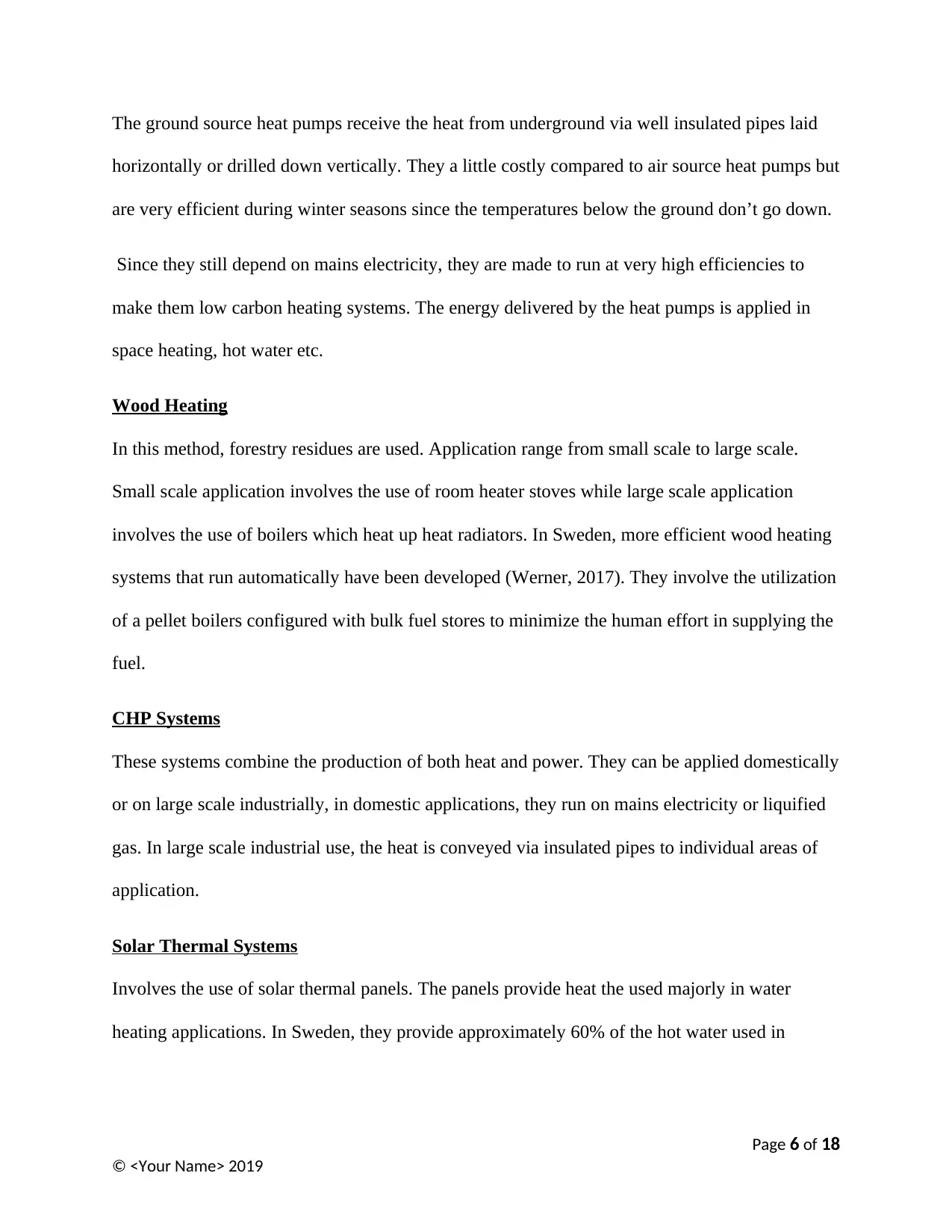
The ground source heat pumps receive the heat from underground via well insulated pipes laid
horizontally or drilled down vertically. They a little costly compared to air source heat pumps but
are very efficient during winter seasons since the temperatures below the ground don’t go down.
Since they still depend on mains electricity, they are made to run at very high efficiencies to
make them low carbon heating systems. The energy delivered by the heat pumps is applied in
space heating, hot water etc.
Wood Heating
In this method, forestry residues are used. Application range from small scale to large scale.
Small scale application involves the use of room heater stoves while large scale application
involves the use of boilers which heat up heat radiators. In Sweden, more efficient wood heating
systems that run automatically have been developed (Werner, 2017). They involve the utilization
of a pellet boilers configured with bulk fuel stores to minimize the human effort in supplying the
fuel.
CHP Systems
These systems combine the production of both heat and power. They can be applied domestically
or on large scale industrially, in domestic applications, they run on mains electricity or liquified
gas. In large scale industrial use, the heat is conveyed via insulated pipes to individual areas of
application.
Solar Thermal Systems
Involves the use of solar thermal panels. The panels provide heat the used majorly in water
heating applications. In Sweden, they provide approximately 60% of the hot water used in
Page 6 of 18
© <Your Name> 2019
horizontally or drilled down vertically. They a little costly compared to air source heat pumps but
are very efficient during winter seasons since the temperatures below the ground don’t go down.
Since they still depend on mains electricity, they are made to run at very high efficiencies to
make them low carbon heating systems. The energy delivered by the heat pumps is applied in
space heating, hot water etc.
Wood Heating
In this method, forestry residues are used. Application range from small scale to large scale.
Small scale application involves the use of room heater stoves while large scale application
involves the use of boilers which heat up heat radiators. In Sweden, more efficient wood heating
systems that run automatically have been developed (Werner, 2017). They involve the utilization
of a pellet boilers configured with bulk fuel stores to minimize the human effort in supplying the
fuel.
CHP Systems
These systems combine the production of both heat and power. They can be applied domestically
or on large scale industrially, in domestic applications, they run on mains electricity or liquified
gas. In large scale industrial use, the heat is conveyed via insulated pipes to individual areas of
application.
Solar Thermal Systems
Involves the use of solar thermal panels. The panels provide heat the used majorly in water
heating applications. In Sweden, they provide approximately 60% of the hot water used in
Page 6 of 18
© <Your Name> 2019
⊘ This is a preview!⊘
Do you want full access?
Subscribe today to unlock all pages.

Trusted by 1+ million students worldwide

domestic applications. Solar thermal systems are seldomly used in space heating. They are very
low carbon systems.
Figure 3: Solar Thermal System
Hybrid Systems
The systems use more than one heating technology. They include the photovoltaic thermal
systems which combine electric panels and thermal collectors, hybrid heat pumps which can
switch to operate on normal fuel, and solar-preheated heat pumps which consists of a solar
collector that pre heats the heat exchange fluid then the heat pump raises the temperature to an
escalated predetermined value required in the point application.
Impact on the Energy System and Other Fuels
The district heating sector in Sweden has played a significant a role in achieving the objectives
of the national policies. During the oil crises of 1970’s the direct heating systems acted as a
technology to replace the oil, the most emphasized objective of the energy policy at the time.
The heating districts have seen Sweden benefit economically. The Sweden heating district
market share had hit 55% in the year 2014 for all the heat that was being supplied to buildings.
With this percentage it was the market leader in Swedish Economy. The growth of the heating
districts has led to development of cooling districts, avenues that are a main source of revenue
Page 7 of 18
© <Your Name> 2019
low carbon systems.
Figure 3: Solar Thermal System
Hybrid Systems
The systems use more than one heating technology. They include the photovoltaic thermal
systems which combine electric panels and thermal collectors, hybrid heat pumps which can
switch to operate on normal fuel, and solar-preheated heat pumps which consists of a solar
collector that pre heats the heat exchange fluid then the heat pump raises the temperature to an
escalated predetermined value required in the point application.
Impact on the Energy System and Other Fuels
The district heating sector in Sweden has played a significant a role in achieving the objectives
of the national policies. During the oil crises of 1970’s the direct heating systems acted as a
technology to replace the oil, the most emphasized objective of the energy policy at the time.
The heating districts have seen Sweden benefit economically. The Sweden heating district
market share had hit 55% in the year 2014 for all the heat that was being supplied to buildings.
With this percentage it was the market leader in Swedish Economy. The growth of the heating
districts has led to development of cooling districts, avenues that are a main source of revenue
Page 7 of 18
© <Your Name> 2019
Paraphrase This Document
Need a fresh take? Get an instant paraphrase of this document with our AI Paraphraser
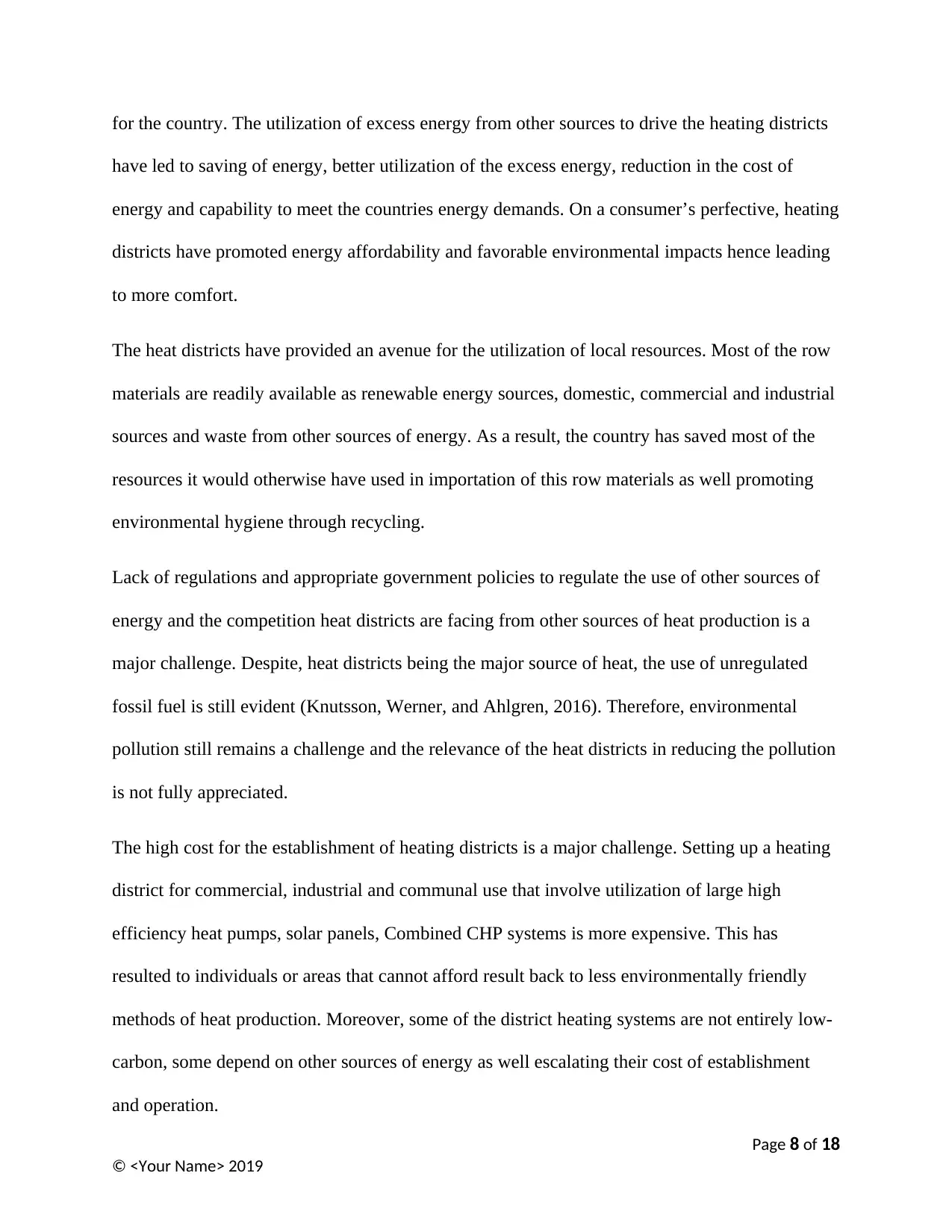
for the country. The utilization of excess energy from other sources to drive the heating districts
have led to saving of energy, better utilization of the excess energy, reduction in the cost of
energy and capability to meet the countries energy demands. On a consumer’s perfective, heating
districts have promoted energy affordability and favorable environmental impacts hence leading
to more comfort.
The heat districts have provided an avenue for the utilization of local resources. Most of the row
materials are readily available as renewable energy sources, domestic, commercial and industrial
sources and waste from other sources of energy. As a result, the country has saved most of the
resources it would otherwise have used in importation of this row materials as well promoting
environmental hygiene through recycling.
Lack of regulations and appropriate government policies to regulate the use of other sources of
energy and the competition heat districts are facing from other sources of heat production is a
major challenge. Despite, heat districts being the major source of heat, the use of unregulated
fossil fuel is still evident (Knutsson, Werner, and Ahlgren, 2016). Therefore, environmental
pollution still remains a challenge and the relevance of the heat districts in reducing the pollution
is not fully appreciated.
The high cost for the establishment of heating districts is a major challenge. Setting up a heating
district for commercial, industrial and communal use that involve utilization of large high
efficiency heat pumps, solar panels, Combined CHP systems is more expensive. This has
resulted to individuals or areas that cannot afford result back to less environmentally friendly
methods of heat production. Moreover, some of the district heating systems are not entirely low-
carbon, some depend on other sources of energy as well escalating their cost of establishment
and operation.
Page 8 of 18
© <Your Name> 2019
have led to saving of energy, better utilization of the excess energy, reduction in the cost of
energy and capability to meet the countries energy demands. On a consumer’s perfective, heating
districts have promoted energy affordability and favorable environmental impacts hence leading
to more comfort.
The heat districts have provided an avenue for the utilization of local resources. Most of the row
materials are readily available as renewable energy sources, domestic, commercial and industrial
sources and waste from other sources of energy. As a result, the country has saved most of the
resources it would otherwise have used in importation of this row materials as well promoting
environmental hygiene through recycling.
Lack of regulations and appropriate government policies to regulate the use of other sources of
energy and the competition heat districts are facing from other sources of heat production is a
major challenge. Despite, heat districts being the major source of heat, the use of unregulated
fossil fuel is still evident (Knutsson, Werner, and Ahlgren, 2016). Therefore, environmental
pollution still remains a challenge and the relevance of the heat districts in reducing the pollution
is not fully appreciated.
The high cost for the establishment of heating districts is a major challenge. Setting up a heating
district for commercial, industrial and communal use that involve utilization of large high
efficiency heat pumps, solar panels, Combined CHP systems is more expensive. This has
resulted to individuals or areas that cannot afford result back to less environmentally friendly
methods of heat production. Moreover, some of the district heating systems are not entirely low-
carbon, some depend on other sources of energy as well escalating their cost of establishment
and operation.
Page 8 of 18
© <Your Name> 2019
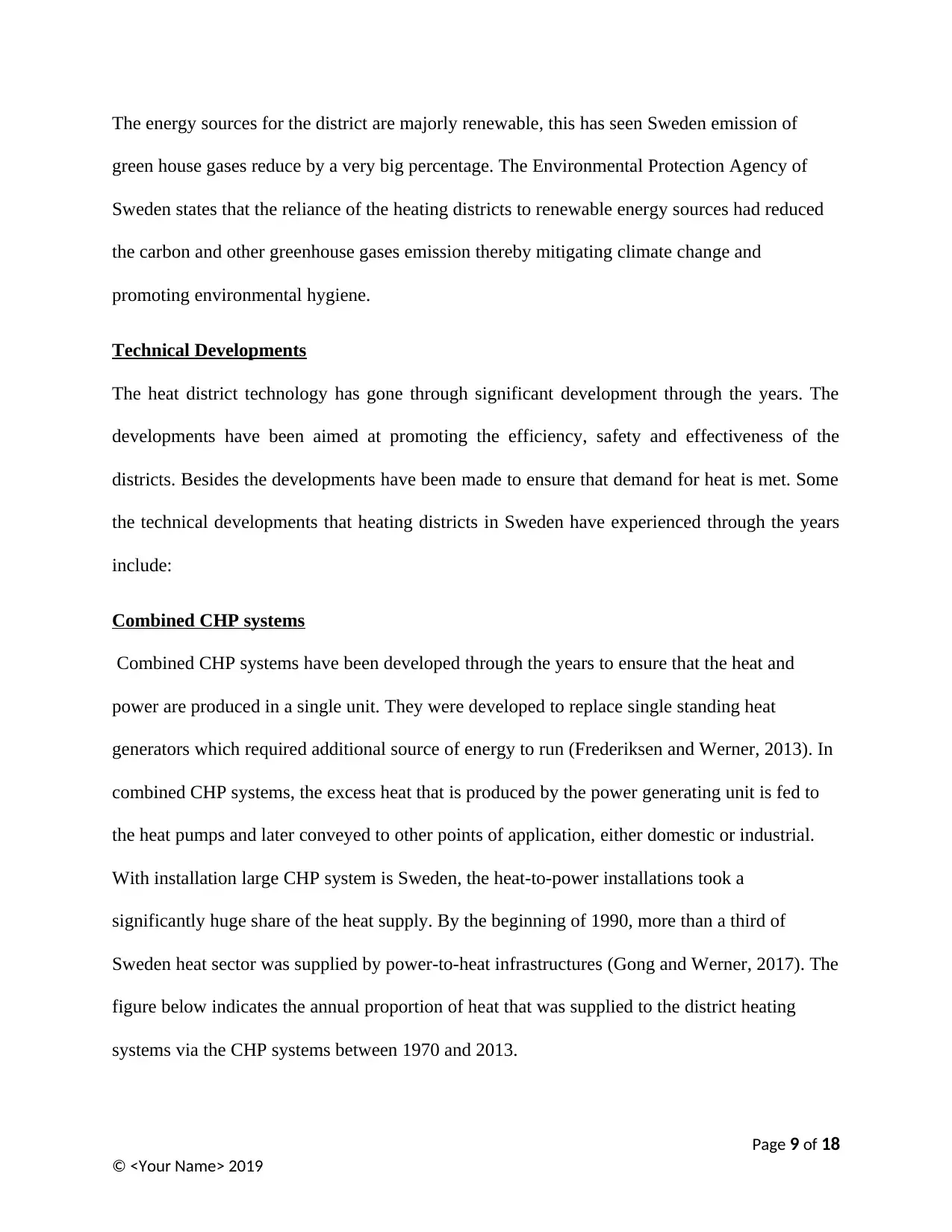
The energy sources for the district are majorly renewable, this has seen Sweden emission of
green house gases reduce by a very big percentage. The Environmental Protection Agency of
Sweden states that the reliance of the heating districts to renewable energy sources had reduced
the carbon and other greenhouse gases emission thereby mitigating climate change and
promoting environmental hygiene.
Technical Developments
The heat district technology has gone through significant development through the years. The
developments have been aimed at promoting the efficiency, safety and effectiveness of the
districts. Besides the developments have been made to ensure that demand for heat is met. Some
the technical developments that heating districts in Sweden have experienced through the years
include:
Combined CHP systems
Combined CHP systems have been developed through the years to ensure that the heat and
power are produced in a single unit. They were developed to replace single standing heat
generators which required additional source of energy to run (Frederiksen and Werner, 2013). In
combined CHP systems, the excess heat that is produced by the power generating unit is fed to
the heat pumps and later conveyed to other points of application, either domestic or industrial.
With installation large CHP system is Sweden, the heat-to-power installations took a
significantly huge share of the heat supply. By the beginning of 1990, more than a third of
Sweden heat sector was supplied by power-to-heat infrastructures (Gong and Werner, 2017). The
figure below indicates the annual proportion of heat that was supplied to the district heating
systems via the CHP systems between 1970 and 2013.
Page 9 of 18
© <Your Name> 2019
green house gases reduce by a very big percentage. The Environmental Protection Agency of
Sweden states that the reliance of the heating districts to renewable energy sources had reduced
the carbon and other greenhouse gases emission thereby mitigating climate change and
promoting environmental hygiene.
Technical Developments
The heat district technology has gone through significant development through the years. The
developments have been aimed at promoting the efficiency, safety and effectiveness of the
districts. Besides the developments have been made to ensure that demand for heat is met. Some
the technical developments that heating districts in Sweden have experienced through the years
include:
Combined CHP systems
Combined CHP systems have been developed through the years to ensure that the heat and
power are produced in a single unit. They were developed to replace single standing heat
generators which required additional source of energy to run (Frederiksen and Werner, 2013). In
combined CHP systems, the excess heat that is produced by the power generating unit is fed to
the heat pumps and later conveyed to other points of application, either domestic or industrial.
With installation large CHP system is Sweden, the heat-to-power installations took a
significantly huge share of the heat supply. By the beginning of 1990, more than a third of
Sweden heat sector was supplied by power-to-heat infrastructures (Gong and Werner, 2017). The
figure below indicates the annual proportion of heat that was supplied to the district heating
systems via the CHP systems between 1970 and 2013.
Page 9 of 18
© <Your Name> 2019
⊘ This is a preview!⊘
Do you want full access?
Subscribe today to unlock all pages.

Trusted by 1+ million students worldwide
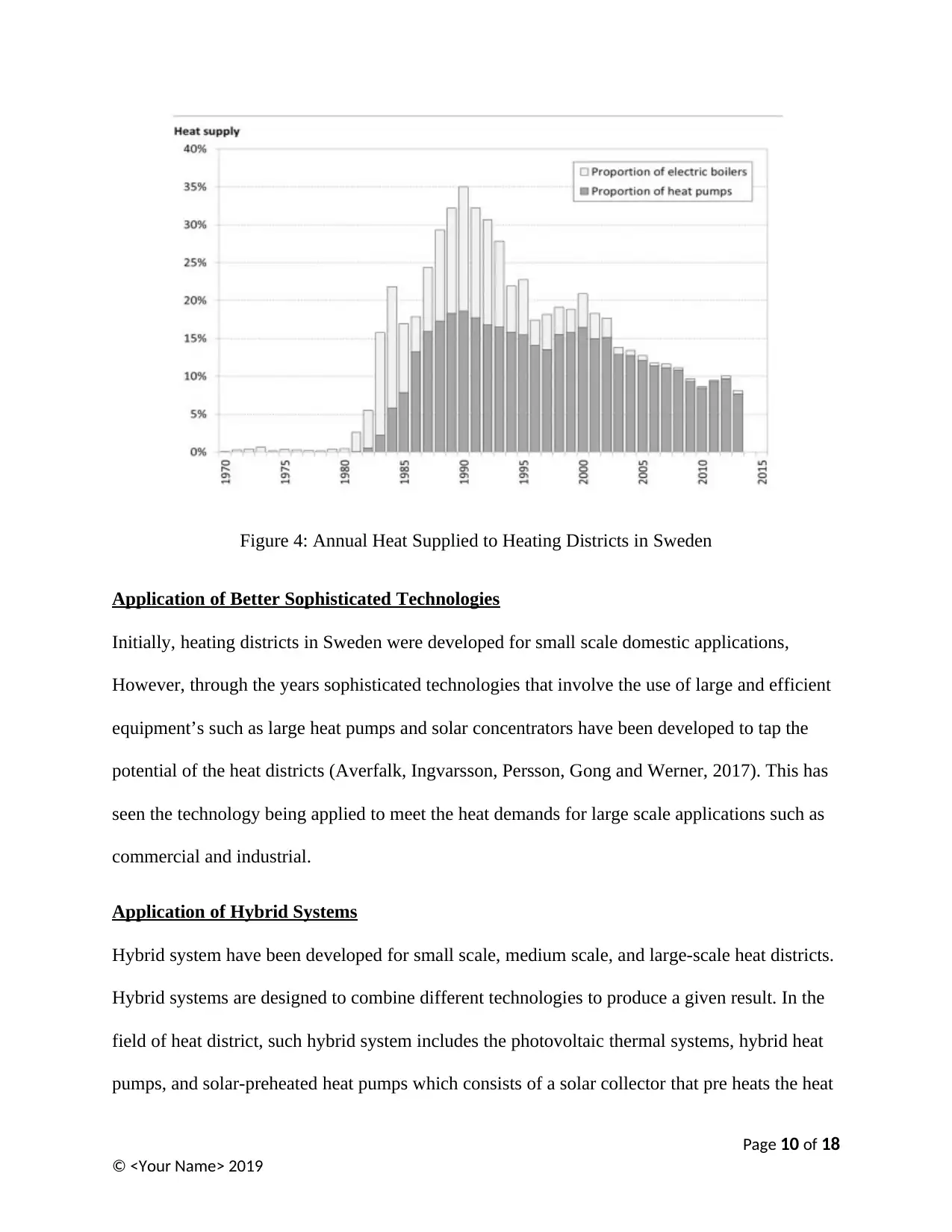
Figure 4: Annual Heat Supplied to Heating Districts in Sweden
Application of Better Sophisticated Technologies
Initially, heating districts in Sweden were developed for small scale domestic applications,
However, through the years sophisticated technologies that involve the use of large and efficient
equipment’s such as large heat pumps and solar concentrators have been developed to tap the
potential of the heat districts (Averfalk, Ingvarsson, Persson, Gong and Werner, 2017). This has
seen the technology being applied to meet the heat demands for large scale applications such as
commercial and industrial.
Application of Hybrid Systems
Hybrid system have been developed for small scale, medium scale, and large-scale heat districts.
Hybrid systems are designed to combine different technologies to produce a given result. In the
field of heat district, such hybrid system includes the photovoltaic thermal systems, hybrid heat
pumps, and solar-preheated heat pumps which consists of a solar collector that pre heats the heat
Page 10 of 18
© <Your Name> 2019
Application of Better Sophisticated Technologies
Initially, heating districts in Sweden were developed for small scale domestic applications,
However, through the years sophisticated technologies that involve the use of large and efficient
equipment’s such as large heat pumps and solar concentrators have been developed to tap the
potential of the heat districts (Averfalk, Ingvarsson, Persson, Gong and Werner, 2017). This has
seen the technology being applied to meet the heat demands for large scale applications such as
commercial and industrial.
Application of Hybrid Systems
Hybrid system have been developed for small scale, medium scale, and large-scale heat districts.
Hybrid systems are designed to combine different technologies to produce a given result. In the
field of heat district, such hybrid system includes the photovoltaic thermal systems, hybrid heat
pumps, and solar-preheated heat pumps which consists of a solar collector that pre heats the heat
Page 10 of 18
© <Your Name> 2019
Paraphrase This Document
Need a fresh take? Get an instant paraphrase of this document with our AI Paraphraser
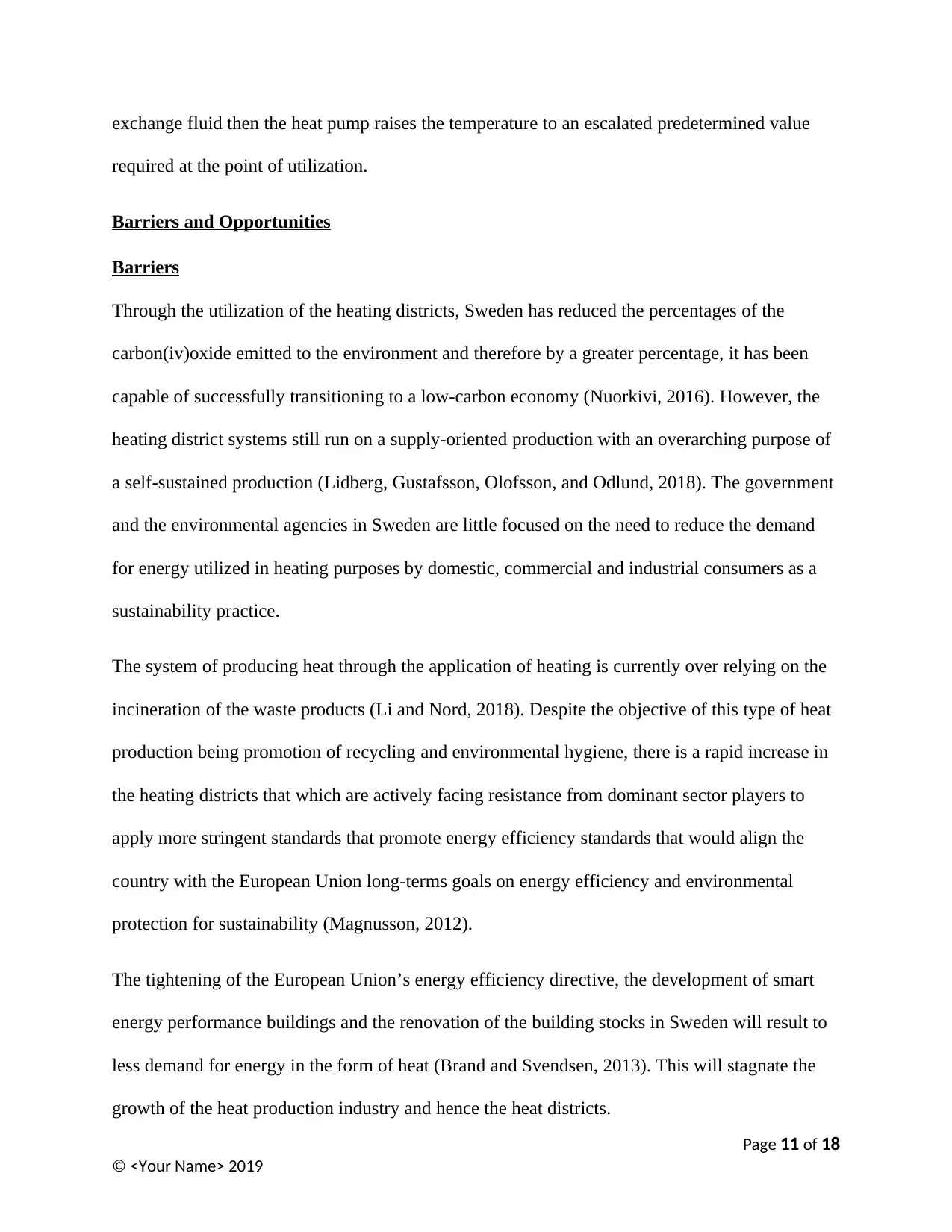
exchange fluid then the heat pump raises the temperature to an escalated predetermined value
required at the point of utilization.
Barriers and Opportunities
Barriers
Through the utilization of the heating districts, Sweden has reduced the percentages of the
carbon(iv)oxide emitted to the environment and therefore by a greater percentage, it has been
capable of successfully transitioning to a low-carbon economy (Nuorkivi, 2016). However, the
heating district systems still run on a supply-oriented production with an overarching purpose of
a self-sustained production (Lidberg, Gustafsson, Olofsson, and Odlund, 2018). The government
and the environmental agencies in Sweden are little focused on the need to reduce the demand
for energy utilized in heating purposes by domestic, commercial and industrial consumers as a
sustainability practice.
The system of producing heat through the application of heating is currently over relying on the
incineration of the waste products (Li and Nord, 2018). Despite the objective of this type of heat
production being promotion of recycling and environmental hygiene, there is a rapid increase in
the heating districts that which are actively facing resistance from dominant sector players to
apply more stringent standards that promote energy efficiency standards that would align the
country with the European Union long-terms goals on energy efficiency and environmental
protection for sustainability (Magnusson, 2012).
The tightening of the European Union’s energy efficiency directive, the development of smart
energy performance buildings and the renovation of the building stocks in Sweden will result to
less demand for energy in the form of heat (Brand and Svendsen, 2013). This will stagnate the
growth of the heat production industry and hence the heat districts.
Page 11 of 18
© <Your Name> 2019
required at the point of utilization.
Barriers and Opportunities
Barriers
Through the utilization of the heating districts, Sweden has reduced the percentages of the
carbon(iv)oxide emitted to the environment and therefore by a greater percentage, it has been
capable of successfully transitioning to a low-carbon economy (Nuorkivi, 2016). However, the
heating district systems still run on a supply-oriented production with an overarching purpose of
a self-sustained production (Lidberg, Gustafsson, Olofsson, and Odlund, 2018). The government
and the environmental agencies in Sweden are little focused on the need to reduce the demand
for energy utilized in heating purposes by domestic, commercial and industrial consumers as a
sustainability practice.
The system of producing heat through the application of heating is currently over relying on the
incineration of the waste products (Li and Nord, 2018). Despite the objective of this type of heat
production being promotion of recycling and environmental hygiene, there is a rapid increase in
the heating districts that which are actively facing resistance from dominant sector players to
apply more stringent standards that promote energy efficiency standards that would align the
country with the European Union long-terms goals on energy efficiency and environmental
protection for sustainability (Magnusson, 2012).
The tightening of the European Union’s energy efficiency directive, the development of smart
energy performance buildings and the renovation of the building stocks in Sweden will result to
less demand for energy in the form of heat (Brand and Svendsen, 2013). This will stagnate the
growth of the heat production industry and hence the heat districts.
Page 11 of 18
© <Your Name> 2019
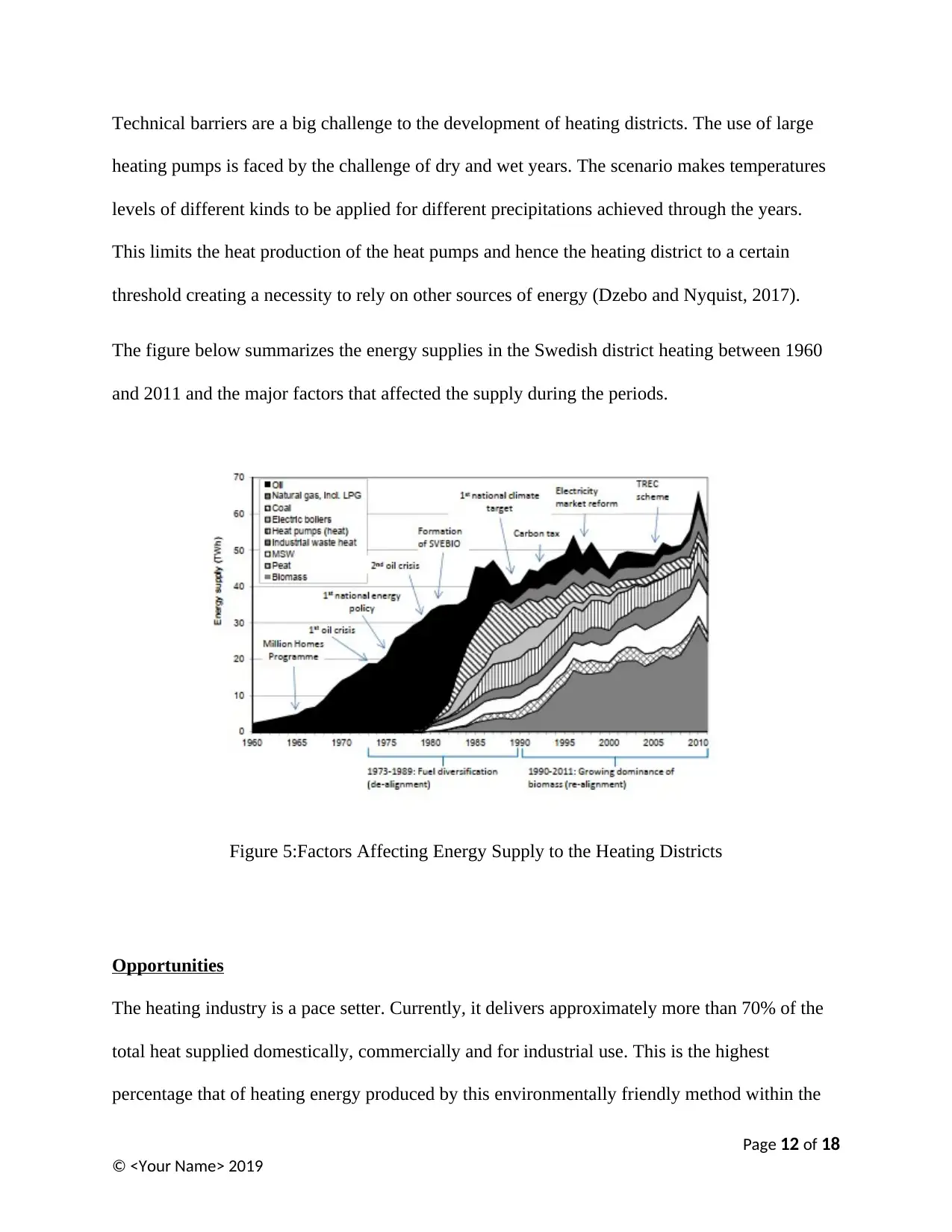
Technical barriers are a big challenge to the development of heating districts. The use of large
heating pumps is faced by the challenge of dry and wet years. The scenario makes temperatures
levels of different kinds to be applied for different precipitations achieved through the years.
This limits the heat production of the heat pumps and hence the heating district to a certain
threshold creating a necessity to rely on other sources of energy (Dzebo and Nyquist, 2017).
The figure below summarizes the energy supplies in the Swedish district heating between 1960
and 2011 and the major factors that affected the supply during the periods.
Figure 5:Factors Affecting Energy Supply to the Heating Districts
Opportunities
The heating industry is a pace setter. Currently, it delivers approximately more than 70% of the
total heat supplied domestically, commercially and for industrial use. This is the highest
percentage that of heating energy produced by this environmentally friendly method within the
Page 12 of 18
© <Your Name> 2019
heating pumps is faced by the challenge of dry and wet years. The scenario makes temperatures
levels of different kinds to be applied for different precipitations achieved through the years.
This limits the heat production of the heat pumps and hence the heating district to a certain
threshold creating a necessity to rely on other sources of energy (Dzebo and Nyquist, 2017).
The figure below summarizes the energy supplies in the Swedish district heating between 1960
and 2011 and the major factors that affected the supply during the periods.
Figure 5:Factors Affecting Energy Supply to the Heating Districts
Opportunities
The heating industry is a pace setter. Currently, it delivers approximately more than 70% of the
total heat supplied domestically, commercially and for industrial use. This is the highest
percentage that of heating energy produced by this environmentally friendly method within the
Page 12 of 18
© <Your Name> 2019
⊘ This is a preview!⊘
Do you want full access?
Subscribe today to unlock all pages.

Trusted by 1+ million students worldwide
1 out of 18
Your All-in-One AI-Powered Toolkit for Academic Success.
+13062052269
info@desklib.com
Available 24*7 on WhatsApp / Email
![[object Object]](/_next/static/media/star-bottom.7253800d.svg)
Unlock your academic potential
Copyright © 2020–2026 A2Z Services. All Rights Reserved. Developed and managed by ZUCOL.

